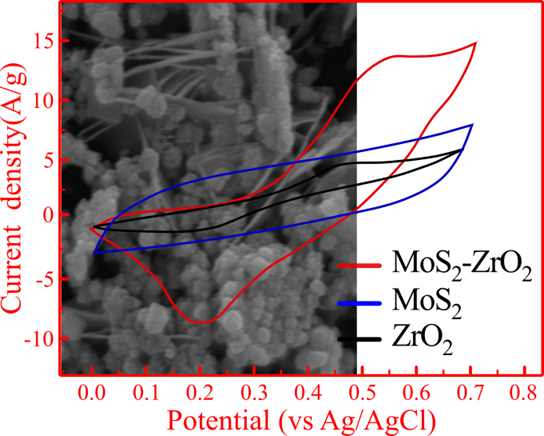Molybdenum disulfide-Zirconium dioxide composite with enhance supercapacitance performance
DOI:
https://doi.org/10.55713/jmmm.v33i4.1791Keywords:
Molybdenum disulfide, Zirconium dioxide, Composite, SupercapacitorAbstract
As a supercapacitor active material, molybdenum disulfide (MoS2) layer offers good conductivity, large surface area, and electrochemical stability. In practice, however, its capacitance is low in comparison to other materials. This work synthesized MoS2-zirconium dioxide (ZrO2) composite in a simple, high-throughput way to test it as a supercapacitor active layer. During the tests, the composite shows a gravimetric capacitance of 500.0 F⸳g-1, while MoS2 and ZrO2 have capacitances of 265.12 and 152.43, respectively. The increase in capacitance of composite stems from the synergistic effect between ZrO2's pseudocapacitor behavior and MoS2's electric double layer capacitance (EDLC). Moreover, the composite has a discharge time of ~ 406 s at a current density of 1 A⸳g-1, which is much longer compared to MoS2 and ZrO2. The stability test of the composite also shows that it maintains 93% of its initial capacitance after 2000 charge/discharge cycles.
Downloads
References
R. Bian, C. Li, Q. Liu, G. Cao, Q. Fu, P. Meng, J. Zhou, F. Liu, and Z. Liu, "Recent progress in the synthesis of novel two-dimensional van der Waals materials," National Science Review, vol. 9, no. 5, 2021.
F. Ghasemi, and A. Salimi, "Advances in 2d based field effect transistors as biosensing platforms: From principle to biomedical applications," Microchemical Journal, vol. 187, p. 108432, 2023.
M. Ali, A. M. Afzal, M. W. Iqbal, S. Mumtaz, M. Imran, F. Ashraf, A. Ur Rehman, and F. Muhammad, "2D-TMDs based electrode material for supercapacitor applications," International Journal of Energy Research, vol. 46, no. 15, pp. 22336-22364, 2022.
O. Samy, S. Zeng, M. D. Birowosuto, and A. El Moutaouakil, "A Review on MoS2 properties, synthesis, sensing applications and challenges," Crystals, vol. 11, no. 4, pp. 355, 2021.
M. Rashidi, and F. Ghasemi, "Thermally oxidized MoS2-based hybrids as superior electrodes for supercapacitor and photo-electrochemical applications," Electrochimica Acta, vol. 435, p. 141379, 2022.
J. Dai, C. Yang, Y. Xu, X. Wang, S. Yang, D. Li, L. Luo, L. Xia, J. Li, X. Qi, A. Cabot, and L. Dai, "MoS2@Polyaniline for aqueous ammonium-ion supercapacitors," Advanced Materials, p. 2303732, 2023.
D. Kasinathan, P. Prabhakar, P. Muruganandam, B. R. Wiston, A. Mahalingam, and G. Sriram, "Solution processed NiO/MoS2 heterostructure nanocomposite for supercapacitor electrode application," Energies, vol. 16, no. 1, pp. 335, 2023.
D. N. Sangeetha, M. S. Santosh, and M. Selvakumar, "Flower-like carbon doped MoS2/Activated carbon composite electrode for superior performance of supercapacitors and hydrogen evolution reactions," Journal of Alloys and Compounds, vol. 831, p. 154745, 2020.
F. Ghasemi, and S. Mohajerzadeh, "Sequential solvent exchange method for controlled exfoliation of MoS2 Suitable for photo-transistor fabrication," ACS Applied Materials & Interfaces, vol. 8, no. 45, pp. 31179-31191, 2016.
J. H. Aguiar Sousa, B. S. Araújo, R. S. Ferreira, A. San-Miguel, R. S. Alencar, and A. G. Souza Filho, "Pressure tuning resonance raman scattering in monolayer, trilayer, and many-layer molybdenum disulfide," ACS Applied Nano Materials, vol. 5, no. 10, pp. 14464-14469, 2022.
E. Mahmoodi, M. H. Amiri, A. Salimi, R. Frisenda, E. Flores, J. R. Ares, I. J. Ferrer, A. Castellanos-Gomez, and F. Ghasemi, "Paper-based broadband flexible photodetectors with van der Waals materials," Scientific Reports, vol. 12, no. 1, pp. 12585, 2022.
C. V. Reddy, B. Babu, I. N. Reddy, and J. Shim, "Synthesis and characterization of pure tetragonal ZrO2 nanoparticles with enhanced photocatalytic activity," Ceramics International, vol. 44, no. 6, pp. 6940-6948, 2018.
F. Ghasemi, and M. Hassanpour Amiri, "Facile in situ fabrication of rGO/MoS2 heterostructure decorated with gold nanoparticles with enhanced photoelectrochemical performance," Applied Surface Science, vol. 570, p. 151228, 2021.
Y. Xiao, S. Li, C. Peng, N. Yang, S. Liu, and S. Yu, "Dual pseudocapacitive electrode/redox electrolyte systems for asymmetric supercabatteries," Applied Surface Science, vol. 616, p. 156552, 2023.
D. Kesavan, V. K. Mariappan, P. Pazhamalai, K. Krishnamoorthy, and S.-J. Kim, "Topochemically synthesized MoS2 nanosheets: A high performance electrode for wide-temperature tolerant aqueous supercapacitors," Journal of Colloid and Interface Science, vol. 584, pp. 714-722, 2021.
Y. Tian, H. Du, M. Zhang, Y. Zheng, Q. Guo, H. Zhang, J. Luo, and X. Zhang, "Microwave synthesis of MoS2/MoO2@CNT nanocomposites with excellent cycling stability for supercapacitor electrodes," Journal of Materials Chemistry C, vol. 7, no. 31, p. 9545-9555, 2019.
S. Giri, D. Ghosh, and C. K. Das, "Growth of vertically aligned tunable polyaniline on graphene/ZrO2 nanocomposites for supercapacitor energy-storage application," Advanced Functional Materials, vol. 24, no. 9, pp. 1312-1324, 2014.

Downloads
Published
How to Cite
Issue
Section
License
Copyright (c) 2023 Journal of Metals, Materials and Minerals

This work is licensed under a Creative Commons Attribution-NonCommercial-NoDerivatives 4.0 International License.
Authors who publish in this journal agree to the following terms:
- Authors retain copyright and grant the journal right of first publication with the work simultaneously licensed under a Creative Commons Attribution License that allows others to share the work with an acknowledgment of the work's authorship and initial publication in this journal.
- Authors are able to enter into separate, additional contractual arrangements for the non-exclusive distribution of the journal's published version of the work (e.g., post it to an institutional repository or publish it in a book), with an acknowledgment of its initial publication in this journal.












